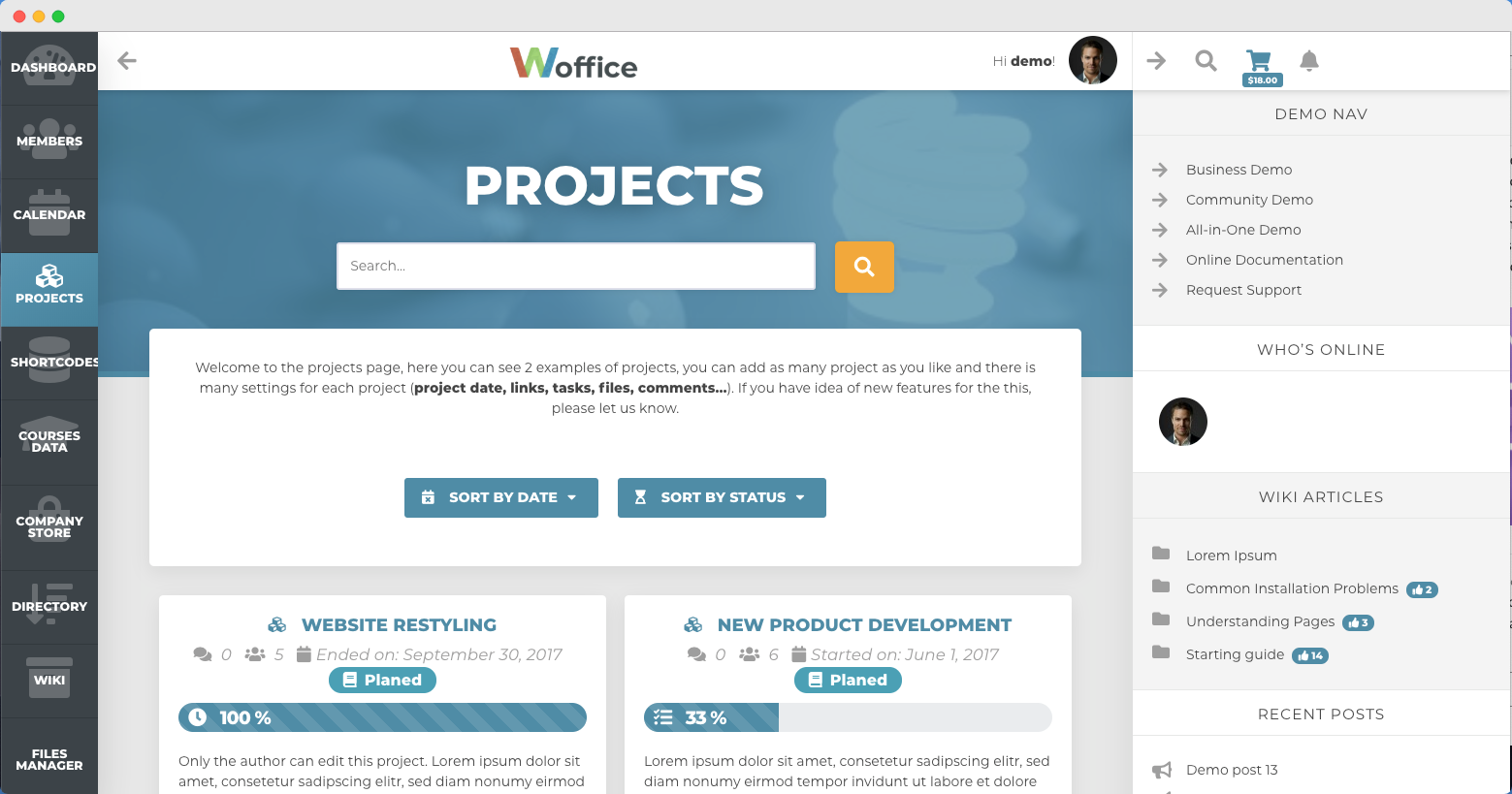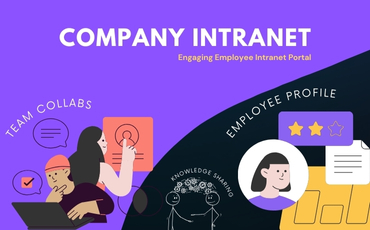Successful organizations choose to use an intranet. And there is a reason for that. Intranets offer
With the increasing number of applications and providers used, it is important for employees to be able to easily keep track of what’s happening in the organization.
But what is an intranet? How is it different from an extranet? How can it benefit my organization?
Without further ado, let’s get into that.
What Is An Intranet?
An intranet is a website or an application operating on the company network and which aims at gathering all the resources of the company in a single place.
In simple terms, you could define it as a database with a beautiful user interface.
By setting up an intranet for your company, you are clustering all the assets of your company, and, as a consequence, you turn your employees toward the same goal: make your company thrive.
A very basic intranet could be made up of a simple shared folder connected to a network: all files in that folder will be visible to other intranet members (depending on their permissions).

That’s being said, the benefits of such intranet would be very limited. The members would share files. They would not leverage any other productivity gain from internal messaging, project management, to task assignment and shared calendars.
If you want to use these features, you need an expert to build a private website (or, possibly, a software system, but a website is much simpler). It doesn’t necessarily need to look cool but it has to work well with all the features requested. Due to the network setup, this website will be accessible only to intranet members.
Up to now, only large and medium-sized companies were using intranets because intranet (let alone extranet) used to be really expensive (more than $200/month for a private network in 2014).
Nowadays, the price issue has been overcome, and companies are able to get a private space by spending way less money.
The intranet market has expanded to smaller businesses and organizations with the increasing number of software providers and the accessibility of WordPress.
Purpose Of An Intranet
An intranet is put in use so that the organization’s employees improve task management and assignment processes, send alerts, communicate, share files and content easily, boost the social atmosphere of the company.
It meant at improving the productivity of the team.
In the end, an intranet is a great way to improve the communication and the information shared inside a company.
Better communication means better workflow: project deadlines are met faster, important files are at your service and easily accessible.
On top of that, it can also decrease your expenses.
So, convinced by the benefits of such intranet?
How Is An Extranet Different?
An extranet is conceptually the same thing but, technically, it is used when the members (in our case – company employees) are located in different places and cannot access the same local server.
A simple example could be a company with offices in different cities. However, you can also use an extranet even if you are in the same building as web servers are way cheaper than private servers.
Benefits Of An Intranet
Sharing Information
All your users can now access and share facts with different permissions according to a defined role – which is relevant to their occupation or department. Thus, you also make sure that everyone in the company is on the same line: you won’t have any guy using the old logo, or the old branding. You are then improving the overall business efficiency.
Curated Content And Saving Time
Owing to the number of changes and updates that tend to occur in your company, but also in your area, week-to-week information can become difficult to find. At Alkalab, we wanted to address this and create a single location where everyone would be able to find an answer to their question.
That’s where the wiki base, or knowledge base, comes in: it allows any teammate – or the ones we want to be able – to create a topic about something he stumbled across, or he simply knows about, and he wants to ensure that this “common” (or not so common) topic is now easily solvable.
Therefore, in this case, your intranet provides you the ability to share resources and best practice between your employees, and so incentivise collaborative working. It can also act as a training platform if you publish online training content for example.
Last but not least, when your guys run into an issue, as they are able to share the “hack”, overtime, you are raising the level of customer service: better access to accurate and consistent information by your staff.
Reducing Costs
As of now, you’ve seen that an intranet allows you to: share companies’ and clients’ information, store valuable resources, train your staff, ease collaboration and interaction ; but it also lets you manage project with, as far as we are concerned, a project management tool. It’s worth noting that you can, of course, add your custom or third-party integration.
As a consequence, you’re reducing your costs by reducing the number of tools and licenses.
Better Communication
What’s more, corporate information such as memos, handbooks, staff news and announcements can be disclosed in one place and store overtime.
With the benefits being covered, we’re now convinced that an intranet is what we need.
Building such an intranet would entail certain costs and take some time.
Lucky us, we have found a cheap solution to build it: WordPress.
Why Would You Choose WordPress For Your Intranet?
WordPress is the most frequently used Content Management System (CMS) in the world. It was born for blogging – but nowadays it is so much more!
● WordPress 26.4% of the web, according to WordPress.com and w3techs
● 62 translations of WordPress are available
● WordPress is behind 30% of the top 1,000 websites
● 54 000+ WordPress plugins and growing daily.
Besides those outstanding facts, WordPress provides a basis for your intranet and lets you customize it.
A lot of features are already provided in themes or plugins, and there are numerous themes built for intranet and extranet.
So, you just need to install a brand new theme and set it up.
Furthermore, you can extend its features in a sec: you have 54K plugins available for you and you can easily create your own, or call out for help from freelancers or WordPress experts.
It offers you a lot of ways to improve your intranet: forum, cache, paid membership, slider, etc.
Intranet Best Practices
User profile and information
Every user can have his/her own page, where important (or less important) information, such as email, phone number, office number, team or group memberships, etc., can be displayed.
Private messages
You can send messages to other members or groups.
Create groups for members
Members can be grouped by work team, section or company department. Groups can also be used for more social purposes.
Here, group membership roles can be managed: by making them visible to all or not, by allowing all members to request joining the group or not.
Internal blogging news
Blog posts are, of course, in the core of WordPress, so you can have a space for news, announcements and official communication available only to the members of your company.
Project and task assignment
This is a very important feature, which can boost your performance. With the right theme or plugin, you can have a space for each project, where you can assign tasks to members, share documents, links or any pieces of information, publish comments or announcements for all members, keep track of progress using the task bar.

Calendar
Taskbar doesn’t require much explanation: you will have a calendar where all employees can see appointments, project deadlines, new events, etc.
File sharing
You can manage folders and subfolders, upload files that the employees have to use on a daily basis.
Knowledge Base
Easily handle a wiki for basic information (something like the following image), including revisions, hierarchy, categories
Manage user membership across your app
You can assign different roles to members, with each role having its own permissions. Members with the right permissions will be able to edit pages, projects, wiki content, publish news and so on.
Members can do everything from the FrontEnd – they will never see the WordPress dashboard and environment, so no need to be a WordPress expert.
Finally, the last point that must be handled thoroughly, as for any WordPress website, is the security. We have shared the best practices when it comes to securing your WordPress website in this article.
As I have already told, if you want your company’s intranet to enjoy good features, you need to use the right theme and plugins.

Woffice is a WordPress theme designed specifically for intranet and extranet. It contains all the core plugins and features that your intranet needs. And it also includes some premium plugins worth $120.
Thus, you can save a lot of money and time.
As of the date of writing this article, 9000+ happy customers have already chosen Woffice for their companies.
Woffice is a responsive theme, so it is accessible from all devices: desktops, laptops, smartphones, and tablets. In addition, it is translation-ready, and it has already been translated into more than taskbar languages!
WordPress Intranet Setup with Additional Plugins
Here is a small list of some other features that can improve your intranet performance. All these features are achievable with plugins perfectly compatible with Woffice:
● Forums with BBpress: It is forum software with a twist from the creators of WordPress. It allows you to easily create and manage a forum space.
● Courses & online teaching with LearnDash: Do you need a training area for your employees? This plugin is perfect for this purpose. It allows creating courses, lessons, assignments and easy management of all contents.
● Badges with BadgeOS: Does your company have the “Best employee of the month” theme? Thanks to this free plugin, you can create achievements and issue sharable badges.
● Albums & videos with rtMedia: Add albums, photos, audio
● Calendar and events with Pro Event Calendar: Provides a stylish and powerful calendar solution for the members of your intranet. This is one of the premium plugins included in Woffice for free.
● Cache with WP Super Cache: This free plugin increases the performance of your pages.
● WordPress document library & wiki with Posts Table Pro. If you have a lot of documents or wiki articles to share in your wiki, then you can make them easier to find by listing them in a searchable, filterable table layout. This premium plugin lists your intranet content in a way that looks fantastic in Woffice. The plugin author has written a detailed tutorial on how to use Posts Table Pro to create a document library or wiki.
Conclusion
In a nutshell, an intranet preserves resources and shift your internal assets, tools and exchanges into one centralized location instead of several scattered locations.
If you or your teammates are tired of dealing with tens of tools every day: Dropbox, Google Drive, Slack, Forums, documents files stored on your server, Pipedrive or any other CRM, HR tool, a project management software, and so on…
This is the sign that an intranet might be a good solution for you.
We hope that this article will give you a taste of how an intranet will bring value to your company.
Feel free to drop any comment, feedback or reaction.






